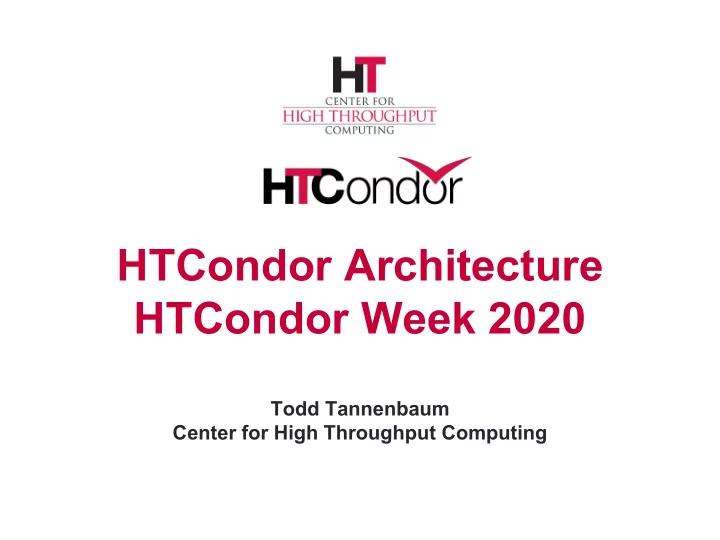

HTCondor Architecture HTCondor Week 2020 Todd Tannenbaum Center for High Throughput Computing
Start with People
People have Problems
“1,000x more “Some of my jobs “My laptop will compute, could need a lot of take three years to revolutionize memory, others a complete my my field ” lot of cores ” analysis, and I want to submit a paper in three weeks ”
“We pay a lot of “If Physics invests “If an important money for research twice what group needs all the computing. I want Chemistry does in computers for three these computers computers, they days to make a always busy, should get 2x the paper deadline, I’m helping research ” computing ” ok with that ”
HTCondor Manages Constraints These constraints Constraints
Not even that easy In the real world, many users, Many resource providers
This is a distributed problem. Distributed because of *people* Not because of machines. Our goal is to satisfy all these constraints.
The Philosophy on 1 slide To reliably run as much work as possible on as many machines as possible Subject to all constraints
The other side: administrator’s To maximize machine utilization *subject to constraints* High Throughput is also High Utilization Computing!
computing
The Unstated Assumption “Work” can be broken up into smaller jobs Smaller the better (up to a point) files as ipc any interdependencies via DAGs Optimize time-to-finish not time-to-run *
Overview of condor: 3 sides Execute Submit Central Manager
We are going to fill in the boxes! Central Manager Submit Machine Execute Machine 14 14
ClassAds: The lingua franca of HTCondor 15
What are ClassAds? ClassAds is a language for objects (jobs and machines) to Express attributes about themselves Express what they require/desire in a “match” (similar to personal classified ads) Structure : Set of attribute name/value pairs, where the value can be a literal or an expression. Semi-structured, no fixed schema. 16
ClassAd Values › Literals Strings ( “RedHat6” ), integers, floats, boolean (true/false), … › Expressions Similar look to C/C++ or Java : operators, references, functions References: to other attributes in the same ad, or attributes in an ad that is a candidate for a match Operators: +, -, *, /, <, <=,>, >=, ==, !=, &&, and || all work as expected Built-in Functions: if/then/else, string manipulation, regular expression pattern matching, list operations, dates, randomization, math (ceil, floor, quantize,…), time functions, eval, … 17 17
Simple Example Machine Ad Job Ad Type = "Machine" Type = "Job" Cpus = 40 Requirements = Memory = 2048 HasMatlabLicense Requirements = == True && (Owner == “gthain”) || Memory >= 1024 (KindOfJob == “simulation”) Rank = kflops + 1000000 Rank = Department == "Math" * Memory HasMatlabLicense = true Cmd= "/bin/sleep" MaxTries = 4 Args = "3600" kflops = 41403 Owner = "gthain" NumJobStarts = 8 KindOfJob = "simulation" Department = "Math" 18
The Magic of Matchmaking › Two ClassAds can be matched via special attributes: Requirements and Rank › Two ads match if both their Requirements expressions evaluate to True › Rank evaluates to a float where higher is preferred; specifies the which match is desired if several ads meet the Requirements. › Scoping of attribute references when matching • MY.name – Value for attribute “name” in local ClassAd • TARGET.name – Value for attribute “name” in match candidate ClassAd • Name – Looks for “name” in the local ClassAd, then the candidate ClassAd 20
ClassAd Types › HTCondor has many types of ClassAds A "Job Ad" represents a job to Condor A "Machine Ad" represents a computing resource Others types of ads represent other instances of other services (daemons), users, accounting records. 21
Architecture & Job Startup
Quick Review of Daemons condor_master: runs on all machine, always plus a condor_procd, condor_shared_port condor_schedd: runs on submit machine condor_startd: runs on execute machine condor_negotiator, condor_collector: runs on central manager 23
Submit Machine Process View condor_master (pid: 1740) condor_procd fork/exec condor_shared_port condor_schedd Tools: condor_submit, condor_q, condor_rm, condor_hold, … fork/exec condor_shadow condor_shadow condor_shadow 24
Execute Machine Process View condor_master (pid: 1740) condor_procd fork/exec condor_shared_port condor_startd condor_starter condor_starter condor_starter Job Job Job 25
Central Manager Process View condor_master (pid: 1740) condor_procd condor_shared_port fork/exec condor_collector condor_negotiator 26
Claiming Protocol Q Central Manager Negotiator Collector J S S Submit Machine Execute Machine J S S S CLAIM Q J J Schedd Startd J Submit 27 27
Claim Activation Central Manager Negotiator Collector Submit Machine Execute Machine CLAIMED Schedd Startd Activate Claim Job Starter Shadow 28 28
Repeat until Claim released Central Manager Negotiator Collector Submit Machine Execute Machine CLAIMED Schedd Startd Activate Claim Job Starter Shadow 29 29
Repeat until Claim released Central Manager Negotiator Collector Submit Machine Execute Machine CLAIMED Schedd Startd Activate Claim Job Starter Shadow 30 30
When is claim released? › When relinquished by one of the following lease on the claim is not renewed • Why? Machine powered off, disappeared, etc schedd • Why? Out of jobs, shutting down, schedd didn’t “like” the machine, etc startd • Why? Policy re CLAIM_WORKLIFE, prefers a different match (via Rank), non-dedicated desktop, etc negotiator • Why? User priority inversion policy explicitly via a command-line tool • E.g. condor_vacate 31
Architecture items to note › Machines (startds) or submitters (schedds) can dynamically appear and disappear Key for expanding a pool into clouds or grids Key for backfilling HPC resources › Scheduling policy can be very flexible (custom attributes) and very distributed › Central manager just makes a match, then gets out of the way › Distributed policy enables federation of resources across different organizations (administrative domains) Lots of network arrows on previous slides Reflects the P2P nature of HTCondor 32
Layout of a General Condor Pool Execute-Only = Process Spawned Central Manager = ClassAd master Communication master Pathway startd negotiator Execute-Only collector Submit-Only master master startd schedd Submit-Only Both! master master startd schedd schedd 33
Thank You!
Recommend
More recommend